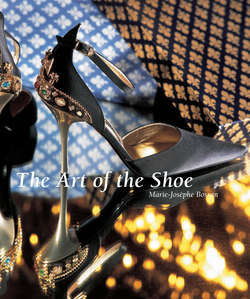Читать книгу The Art of the Shoe - Marie-Josèphe Bossan - Страница 21
На сайте Литреса книга снята с продажи.
From Antiquity up to our days
Shoes and Poverty
ОглавлениеIn the wake of the Second Empire’s Fête Impériale or Imperial Celebration, the taste for magnificent clothing was matched with opulence in the art of the shoe. Examples of these styles, worn by the aristocracy and the increasingly wealthy bourgeoisie, can be seen today in public and private collections. Evidence of the fashions of their times, they are proof of the traditional expertise handed down from one generation to the next, revealing the individuality and the craftsmanship of their creators, whether famous or anonymous. On the other hand, the less well-dressed lower classes wore their shoes until thoroughly deteriorated; so common was this reality, these shoes are rarely preserved today. Nevertheless, images of these shoes survive, thanks to the art of painting. The writer Pierre-Joseph Proudhon (1809–1865), a friend of Gustave Courbet (1819–1877), taught that art should serve society and extol social demands. Although Napoleon III cared about improving the workers’ hard lot, social conflicts remained and shook the traditional value system despite his efforts. Artists responded to what was going on around them by depicting in their painting the economic and social transformation brought on by the machine and industrialization. German painter Adolph Menzel (1815–1905) first visited Paris in 1855. At the World Fair he discovered the pavilion devoted to Courbet’s realism. Menzel was a court painter who commemorated ceremonies and celebrations, but he was also interested in factory labour, and looked at people with sincere and honest interest. This was important because an artist first had to consider the worker a worthy subject before the worker could become the painting’s focal point. In The Rolling Mill (Nationalgalerie Staatliche Museum zu Berlin Preussischer Kulturbesitz), dated 1872–1875, labourers are depicted busy at work dressed in crude, old shoes with worn-down heels, worn without stockings. The writer and art critic Champfleury, author of a book on popular imagery and contributor to the socialist journal The People’s Voice, inspired the painter Gustave Courbet. Courbet depicted the modest shoes worn by the working classes in his socialist paintings, such as The Stone Breakers, which disappeared from the Dresden Museum during the Second World War, and The Burial at Ornans. The Stone Breakers features a pair of clogs worn by the worker in right foreground, of which the left one is cracked inside. The worker moving rocks in the left foreground better protects his feet with rustic laced shoes of crude leather. The Burial at Ornans depicts poor and prominent villagers gathered for an indigent’s burial in a communal plot. The sharp contrast between the different social classes is echoed by their shoes: the grave digger’s simple laced shoes are worn out, whereas the elegant black shoes worn by the society figures look like new.
The son of a peasant, Jean-François Millet (1814–1875) painted scenes of rural life, each one a testament to the peasant’s humble labour and the nobility of man on earth. Farm hands, who were day workers, are usually depicted in simple clogs, as seen in The Angelus (1857–1859), The Wood Splitter, and The Gleaners (Salon of 1857).
The painter Jules Breton was also interested in peasant life and painted lively scenes. In the Call of the Gleaners (Salon of 1859), he depicts young women in clogs or bare feet. A lack of shoes was a sign of abject poverty, symbolized by the French expression “va-nu-pieds,” which literally means, “who goes barefoot.” As Jean-Paul Roux explains: “During the middle ages wearing shoes became one of the primary indicators a person was well born. It was of such importance that for a long time the feudal lord sometimes carried peasant shoes alongside leather ones! This is but a survival. The man with shoes was everything, the shoeless person was nothing. Va-nu-pieds! This expression, now a fixed label, has no real meaning today and we rarely use it. Yet quite recently, hundreds of years or more, in the unequivocal testimony of nineteenth-century novelists, the phrase carried its full weight as a synonym of the word beggar, and signified a man so poor he could not even pay for a pair of shoes.”
79. Jean Beraud. Parisian, place de la Concorde. Carnavalet Museum, Paris. Photo by Ladet, PMVP.
80. Miniature bottine in glossy kidskin, openworked upper, remarkable stitching producing the effect of leather lace, laced on the side; leather sole, reel heel. Executed by Rousselle. Second Empire. International Shoe Museum, Romans.
81. Hand embroidered woman’s bottine in satin. Executed by Pinet. Paris, around 1875. International Shoe Museum, Romans.
82. Miniature woman’s shoe in black kidskin, scalloped vamp, upper laced by a brown silk ribbon ending in a bow, leather sole, Louis XV heel. France, around 1880. International Shoe Mueum, Romans.
